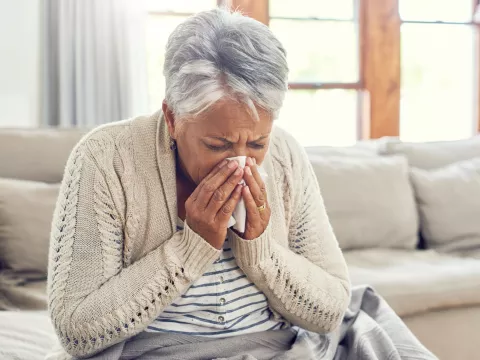- AdventHealth

Choose the health content that’s right for you, and get it delivered right in your inbox.
Allergies are nothing to sneeze at as the sixth leading cause of long-term illness in the United States, and more than 50 million Americans experience an allergic reaction each year. We’re here to explain how allergies occur, symptoms, who typically gets them, the most common types of allergies and treatment options for relief.
How Do Allergies Occur?
Allergies occur from an abnormal immune response to certain environmental agents or proteins in specific foods. The symptoms are the body’s way of reacting against what it perceives as dangerous. Allergic reactions can be mild, moderate or severe. There is currently no cure for allergies. However, there are therapies and lifestyle choices that can help.
Allergy Symptoms
It’s important to treat symptoms immediately before they get worse. Seek medical attention right away for emergency symptoms like:
- Anaphylaxis (look for constriction/tightening of the airways, lump in the throat, dizziness, confusion, loss of consciousness)
- Hives or itchy skin
- Dizziness, lightheadedness or fainting
- Itching or tingling in or around the mouth
- Nasal congestion
- Stomach pain, diarrhea or nausea
- Swollen lips, face, tongue or throat
- Vomiting (likely due to throat swelling rather than gastrointestinal issues)
- Wheezing
Types of Allergies
A person can be allergic to anything, from foods to pets to something you touch or inhale outdoors. Here are some of the most common allergy types.
Seasonal and Inhalant Allergies
Seasonal allergies, which can coincide with inhalant allergies, affect millions of people every year. If you notice itchy, watery eyes, a stuffy or runny nose, cough, wheeze, sore throat and congestion that coincide with a change in seasons, it may be allergies. What might be confused as cold symptoms that last many weeks may be an allergy rather an infection. If this is the case, be sure to let your provider know.
Other inhalant allergies can be caused by airborne substances like dust or mold. Children and adults with asthma need to be especially careful as inhaling allergens can trigger or worsen your asthma.
Skin Allergies
The Centers for Disease Control and Prevention (CDC) reports that cases of skin allergies have increased by more than 5% between 1997 and 2011 in people under 18 years old with skin conditions like eczema. Luckily, the prevalence tends to decrease with age. They’re typically easy to identify due to the visible reaction that occurs.
Skin reactions can happen in adults as well. Symptoms include localized itching, swelling, burning, redness, rash and hives. Some skin reactions can indicate a very serious (systemic) allergic reaction. Call 911 right or get to your nearest ER right away if you experience any of the following:
- You have hives all over your body
- You’re having trouble breathing
Make an appointment with your provider if:
- You need help managing your eczema
- Your rash is bleeding, has pus and looks infected
- You think you may have an allergy that you didn’t have before
- You have a skin rash that doesn’t get better within a few weeks
Food Allergies
The prevalence of food allergies in children is a growing concern. Adults can also have severe food allergies, and many kids never outgrow them. Here are some of the most common food allergies to look out for along with some tips on how to manage them.
Dairy and Egg Allergies
Avoid foods that contain milk, milk powder, butter and cream. Cow’s milk is most commonly the source of milk allergies. Some people with cow’s milk allergies may be able to have goat’s or sheep’s milk, but many cannot have these, either.
Look for alternative, plant-based milks, such as rice or oat, that do not conflict with other food allergies you may have, like nuts or soy. If you do not have a nut or soy allergy, almond, cashew and soy milks are popular alternatives.
Most kids with an egg allergy are actually allergic to the egg whites rather than the yolks. As common as egg allergies are in children, they’re also among the most common food allergies that are eventually outgrown.
Fish and Shellfish Allergies
Fish allergies are common, but they may be confused with an adverse reaction to contaminated fish. It’s common for fish allergies to develop later in life rather than in childhood. For kids with shellfish allergies, avoid shrimp, prawns, crayfish, lobster, squid and scallops.
Peanut Allergies
Peanut allergies can be fatal. Some kids can’t even touch or inhale residue from peanuts. When eating out or in public, always let those who will be handling your food know of your allergy and that care must be taken to avoid cross-contamination with other foods. It's uncommon to outgrow a peanut allergy, and they often grow worse with every exposure.
Tree Nut Allergies
Examples of common tree nuts are almonds, walnuts, pine nuts, macadamia nuts, cashews and coconuts. Avoid any product that contains specific allergens, such as nut butters, nut milks and nut oils.
If you have a known tree nut allergy, watch out for the use of nut oils in hand creams, body lotion and other products.
Soy Allergies
Soy is found in many foods, so always be mindful to read the labels. Avoid soybeans (edamame), soy milk, soy sauce and tofu.
Wheat Allergies
A true wheat allergy is different from celiac disease or gluten sensitivity, which both disrupt the digestive system but are not life-threatening. A wheat allergy causes an abnormal immune response to one of the many proteins found in wheat.
Pet Allergies
Pet allergies are allergic responses to the proteins found in a cat or dog's skin cells, saliva or urine. They’re most often triggered by exposure to pet dander. When you’re around a pet, the symptoms are like what you might experience with seasonal allergies and sometimes skin allergies including itchiness, wheezing, swelling, hives and sneezing.
Venoms and Stinging Insects
Stinging insects can inject venom, a poisonous substance. The venom in insect stings can cause a severe allergic reaction. The most common stinging insects that cause allergic reactions include:
- Bees
- Fire ants
- Hornets
- Wasps
- Yellowjackets
Food Protein Induced Enterocolitis Syndrome (FPIES)
Like other food allergies, FPIES reactions are triggered by eating a particular food. But this type of allergy is often misdiagnosed at first due to its symptoms of vomiting, diarrhea and low blood pressure. An FPIES reaction can cause severe dehydration that requires medical attention. There is no blood or skin test to confirm FPIES, so your allergist will likely recommend avoiding trigger food(s). Fortunately, most children outgrow this condition by age 4.
Who Gets Allergies?
Anyone can get allergies, but they tend to run in families. If you or your spouse have them, it’s more likely you might have a child with allergies.
Your environment also influences whether you’ll develop allergies. Exposure to an allergen will tend to cause an allergic reaction. The more intense the exposure, the more often you’re in contact with the allergen and the earlier it happens in their life, the more likely you’ll develop an allergy.
Other factors that influence who develop allergies include whether and how much you’re exposed to smoke, pollution or infections. Hormones can also play a role.
Treatment Options for Allergies
Your primary care provider is your best resource to know how to treat your specific allergy or allergies. If you or your child have severe allergies, your provider may refer you to an allergist for more specialized treatment.
In general, these are some of the best, most effective treatment options for allergies:
- Allergy shots
- Antihistamines like Benadryl
- Decongestants
- Limiting exposure to allergens
Using an EpiPen Auto-Injector
Anaphylaxis can be life-threatening. People and parents of children with severe allergies typically carry an EpiPen (contains the hormone epinephrine), which can be used in emergencies to counteract severe allergic reactions or anaphylaxis. If you do use the EpiPen, you still need to get you or your child to the hospital. Antihistamines such as Benadryl can be used for mild or moderate reactions. The key is to make sure the airways stay open with no difficulty breathing.
Epinephrine pens are available by prescription and the medication is usually administered via an auto-injector, a medical device used for injecting a measured dose or doses of the medication.
Instructions on the package should be followed carefully as there are several auto-injectors available in the United States. Be sure to ask your provider if you have questions.
Whole-Person Care That Helps Your Breathe Easier
Our goal is for you to feel whole. So, if allergies or asthma are slowing you down, know that our care team is here to lift you up in body, mind and spirit.
Find a primary care provider and learn more about how we can partner with you in managing your allergies.



